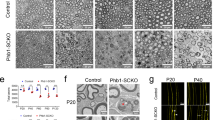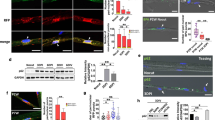Abstract
The protein component of the myelin layer is essential for all aspects of peripheral nerves, and its deficiency can lead to structural and functional impairment. The presence of peripheral myelin protein 2 (P2, PMP2, FABP8, M-FABP) in Schwann cells has been known for decades and shown recently to be involved in the lipid homeostasis in the peripheral neural system. However, its precise role during de- and remyelination has yet to be elucidated. To this end, we assessed remyelination after sciatic nerve crush injury in vivo, and in an experimental de/remyelination ex vivo myelinating culture model in P2-deficient (P2 −/− ) and wild-type (WT) animals. In vivo, the nerve crush paradigm revealed temporal structural and functional changes in P2 −/− mice as compared to WT animals. Concomitantly, P2 −/− DRG cultures demonstrated the presence of shorter internodes and enlarged nodes after ex vivo de/remyelination. Together, these data indicate that P2 may play a role in remyelination of the injured peripheral nervous system, presumably by affecting the nodal and internodal configuration.




Similar content being viewed by others
Abbreviations
- d:
-
Days
- dML:
-
Distal motor latency
- CMAP:
-
Maximum compound muscle action potential
- CMT:
-
Charcot–Marie–Tooth
- DRG:
-
Dorsal root ganglia
- FABP:
-
Fatty acid binding protein
- FKL:
-
Forskolin
- GAPDH:
-
Glyceraldehyde-3-phosphate dehydrogenase
- MBP:
-
Myelin basic protein
- MHC:
-
Major histocompatibility complex
- NCV:
-
Nerve conduction velocity
- P0:
-
Protein zero
- P2:
-
Peripheral myelin protein 2
- P2−/− :
-
P2-deficient
- RT:
-
Room temperature
- rtPCR:
-
Real-time polymerase chain reaction
- SNCI:
-
Sciatic nerve crush injury
- WT:
-
Wildtype
References
Bharucha VA, Peden KW, Subach BR, Narayanan V, Tennekoon GI (1993) Characterization of the cis-acting elements of the mouse myelin P2 promoter. J Neurosci Res 36:508–519
Brown MC, Hardman VJ (1987) A reassessment of the accuracy of reinnervation by motoneurons following crushing or freezing of the sciatic or lumbar spinal nerves of rats. Brain 110(Pt 3):695–705
Court FA et al (2004) Restricted growth of Schwann cells lacking Cajal bands slows conduction in myelinated nerves. Nature 431:191–195
De Leon M, Welcher AA, Suter U, Shooter EM (1991) Identification of transcriptionally regulated genes after sciatic nerve injury. J Neurosci Res 29:437–448
Dehmel T, Janke A, Hartung HP, Goebel HH, Wiendl H, Kieseier BC (2007) The cell-specific expression of metalloproteinase-disintegrins (ADAMs) in inflammatory myopathies. Neurobiol Dis 25:665–674. doi:10.1016/j.nbd.2006.11.008
Gonzaga-Jauregui C et al (2015) Exome sequence analysis suggests that genetic burden contributes to phenotypic variability and complex. Neuropathy Cell Rep 12:1169–1183
Greenfield S, Brostoff S, Eylar EH, Morell P (1973) Protein composition of myelin of the peripheral nervous system. J Neurochem 20:1207–1216
Harauz G, Ladizhansky V, Boggs JM (2009) Structural polymorphism and multifunctionality of myelin basic protein. Biochemistry 48:8094–8104
Hong YB et al (2016) A mutation in PMP2 causes dominant demyelinating Charcot-Marie-Tooth neuropathy. PLoS Genet 12:e1005829
Hughes RA et al (2008) Intravenous immune globulin (10% caprylate-chromatography purified) for the treatment of chronic inflammatory demyelinating polyradiculoneuropathy (ICE study): a randomised placebo-controlled trial. Lancet 7:136–144
Inglis HR, Csurhes PA, McCombe PA (2007) Antibody responses to peptides of peripheral nerve myelin proteins P0 and P2 in patients with inflammatory demyelinating neuropathy. J Neurol Neurosurg Psychiatry 78:419–422
Kadlubowski M, Hughes RA, Gregson NA (1984) Spontaneous and experimental neuritis and the distribution of the myelin protein P2 in the nervous system. J Neurochem 42:123–129
Khalili-Shirazi A, Atkinson P, Gregson N, Hughes RA (1993) Antibody responses to P0 and P2 myelin proteins in Guillain-Barre syndrome and chronic idiopathic demyelinating polyradiculoneuropathy. J Neuroimmunol 46:245–251
Kirschner DA, Ganser AL (1980) Compact myelin exists in the absence of basic protein in the shiverer mutant mouse. Nature 283:207–210
Knoll W et al (2014) Structural and dynamical properties of reconstituted myelin sheaths in the presence of myelin proteins MBP and P2 studied by neutron scattering. Soft Matter 10:519–529
Lehmann HC et al (2009) Matrix metalloproteinase-2 is involved in myelination of dorsal root ganglia neurons Glia 57:479–489 doi:10.1002/glia.20774
Lemke G, Axel R (1985) Isolation and sequence of a cDNA encoding the major structural protein of peripheral myelin. Cell 40:501–508
Luft JH (1961) Improvements in epoxy resin embedding methods. J Biophys Biochem Cytol 9:409–414
Majava V et al (2010) Structural and functional characterization of human peripheral nervous system myelin protein P2. PLoS ONE 5:e10300
Meyer zu Horste G et al (2010) Mouse Schwann cells activate MHC class I and II restricted T-cell responses, but require external peptide processing for MHC class II presentation. Neurobiol Dis 37:483–490. doi:10.1016/j.nbd.2009.11.006
Meyer zu Horste G et al (2014) FoxP3+ regulatory T cells determine disease severity in rodent models of inflammatory neuropathies. PLoS ONE 9:e108756
Motley WW et al (2016) De novo PMP2 mutations in families with type 1 Charcot-Marie-Tooth disease. Brain 139:1649–1656
Rostami A, Brown MJ, Lisak RP, Sumner AJ, Zweiman B, Pleasure DE (1984) The role of myelin P2 protein in the production of experimental allergic neuritis. Ann Neurol 16:680–685
Ruskamo S et al (2014) Atomic resolution view into the structure-function relationships of the human myelin peripheral membrane protein P2. Acta Crystallogr 70:165–176
Samsam M, Frei R, Marziniak M, Martini R, Sommer C (2002) Impaired sensory function in heterozygous P0 knockout mice is associated with nodal changes in sensory nerves. J Neurosci Res 67:167–173
Sanders FK, Whitteridge D (1946) Conduction velocity and myelin thickness in regenerating nerve fibres. J Physiol 105:152–174
Saporta MA, Katona I, Lewis RA, Masse S, Shy ME, Li J (2009) Shortened internodal length of dermal myelinated nerve fibres in Charcot-Marie-Tooth disease type 1A. Brain 132:3263–3273
Sedzik J, Jastrzebski JP (2011) High-resolution structural model of porcine P2 myelin membrane protein with associated fatty acid ligand: fact or artifact? J Neurosci Res 89:909–920
Stettner M, Dehmel T, Mausberg AK, Kohne A, Rose CR, Kieseier BC (2011) Levetiracetam exhibits protective properties on rat Schwann cells in vitro. J Peripher Nerv Syst 16:250–260
Stettner M et al (2013a) Promoting myelination in an in vitro mouse model of the peripheral nervous system: the effect of wine ingredients [corrected]. PLoS ONE 8:e66079
Stettner M et al (2013b) A reliable in vitro model for studying peripheral nerve myelination in mouse. J Neurosci Methods 214:69–79
Stettner M et al (2014) Interleukin-17 impedes Schwann cell-mediated myelination. J Neuroinflamm 11:63
Suresh S, Wang C, Nanekar R, Kursula P, Edwardson JM (2010) Myelin basic protein and myelin protein 2 act synergistically to cause stacking of lipid bilayers. Biochemistry 49:3456–3463
Trapp BD, McIntyre LJ, Quarles RH, Sternberger NH, Webster HD (1979) Immunocytochemical localization of rat peripheral nervous system myelin proteins: P2 protein is not a component of all peripheral nervous system myelin sheaths. Proc Natl Acad Sci USA 76:3552–3556
Trapp BD, Dubois-Dalcq M, Quarles RH (1984) Ultrastructural localization of P2 protein in actively myelinating rat Schwann cells. J Neurochem 43:944–948
Uyemura K, Yoshimura K, Suzuki M, Kitamura K (1984) Lipid binding activities of the P2 protein in peripheral nerve myelin. Neurochem Res 9:1509–1514
Wu LM, Williams A, Delaney A, Sherman DL, Brophy PJ (2012) Increasing internodal distance in myelinated nerves accelerates nerve conduction to a flat maximum. Curr Biol 22:1957–1961
Zenker J et al (2014) A role of peripheral myelin protein 2 in lipid homeostasis of myelinating Schwann cells. Glia 62:1502–1512
Acknowledgements
The excellent technical assistance of Zippora Kohne and Jean-Jacques Médard is greatly appreciated. We thank Kathleen Ingenhoven for her great support in the lab.
Funding
No funding was received for the current study.
Author information
Authors and Affiliations
Contributions
Authors’ Contributions
Study concept and design: MS, and BK. Acquisition of data: MS, FK, FS, JPW, TD, AKM. Analysis and interpretation of data: MS, JZ, RC, BCK. Drafting of the manuscript: MS, and BK. Critical revision of the manuscript for important intellectual content: MS, BK, JZ, RC, CK. Statistical analysis: MS, FK, FS, AKM. BK. Study supervision: MS, and BK. All authors have read and approved the final version of the manuscript.
Corresponding author
Ethics declarations
Competing interest
The authors declare that they have no competing interests.
Informed Consent
The manuscript does not contain any individual person’s data in any form. Not applicable.
Ethical Approval
All experiments implicating animals were performed in accordance with the legal requirements of the University of Düsseldorf and the “Landesamt für Natur- und Umweltschutz Nordrhein-Westfalen” (Regional Office for Nature, Environment and Consumer Protection), Germany.
Rights and permissions
About this article
Cite this article
Stettner, M., Zenker, J., Klingler, F. et al. The Role of Peripheral Myelin Protein 2 in Remyelination. Cell Mol Neurobiol 38, 487–496 (2018). https://doi.org/10.1007/s10571-017-0494-0
Received:
Accepted:
Published:
Issue Date:
DOI: https://doi.org/10.1007/s10571-017-0494-0




